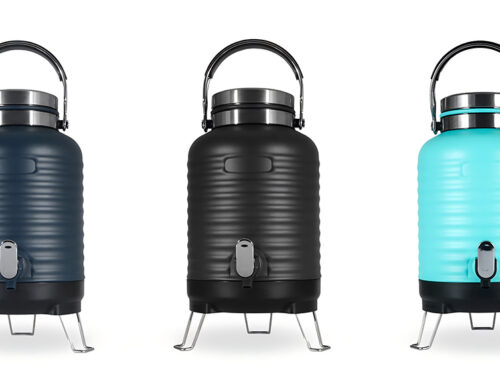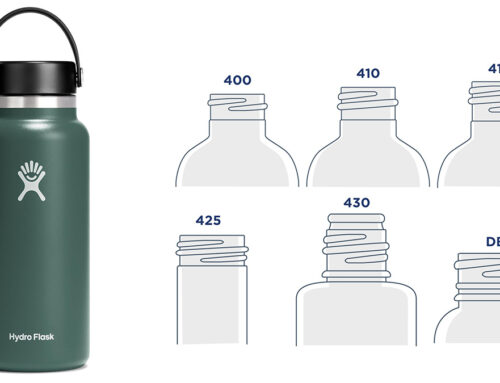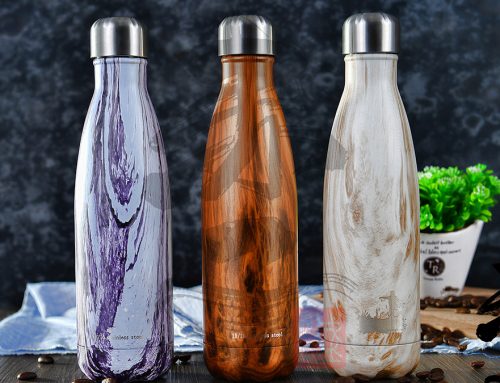Most commonly used environmentally friendly materials for vacuum insulated water bottles are 304 stainless steel and 316 stainless steel. Both 304 stainless steel and 316 stainless steel are very healthy and environmentally friendly materials, with only minor differences. Here comes some comparison.
Material Characteristics
304 stainless steel
As the most widely used stainless steel, it is used in food equipment, general chemical equipment, atomic energy industry, etc.; high ductility, corrosion resistance, heat resistance, low temperature strength, good mechanical properties; deep drawing, bending and other normal temperature processing properties Preferably, it does not harden after heat treatment; non-magnetic; use temperature: -196 to 800 °C.
316 stainless steel
Mo is added, which is particularly resistant to corrosion, air corrosion and high temperature, and is suitable for use in harsh conditions. Work hardening performance is good. Seawater equipment, chemicals, paper, fertilizer production equipment, photography, food industry.
The following is a comparison of the two materials.
| Type | 304 stainless steel | 316 stainless steel |
| Corrosion Resistance | Good | Excellent |
| Ductility | Good | Good |
| Welding Performance | Excellent | Excellent |
| Raw Material Price | About CNY20/KG | About CNY30/KG |
Explainer Video: Material Guide for Water Bottle Tumbler Cup
Material Processing Technology and Characteristics
Processing technology
304 is welded with H0Cr21Ni10, solution treatment after welding;
316 is welded with H0Cr19Ni12Mo2, solution treatment at 1050-1100 degrees Celsius after welding;
Welding Characteristics (304 and 316)
1. Brazing heating temperature is low, the joint is smooth and flat, the structure and mechanical properties change little, the deformation is small, and the workpiece size is accurate.
2. Weldable dissimilar metals can also be welded to dissimilar materials, and there is no strict limit on the thickness difference of the workpiece.
3. Some brazing methods can weld multiple weldments and multiple joints at the same time, and the productivity is high.
4. The brazing equipment is simple and the production investment cost is small.
5. The joint strength is low, the heat resistance is poor, and the pre-weld cleaning requirements are strict, and the brazing material is expensive.
304 Stainless Steel
Comparing with 316, 304 is more popularly used in the thermos bottle industry. The following highlights 304.
304 stainless steel is a common material in stainless steel. It is also called 18/8 stainless steel in the industry. It is a healthy material. It is now a recognized health material that can be used in medical treatment and implanted in human body. For 304 stainless steel, the Ni element in its composition is very important, which directly determines the corrosion resistance of 304 stainless steel and its value. The important elements in 304 are Ni, Cr, but are not limited to these two elements. The specific requirements are stipulated by the product standard. Common judgments in the industry consider that as long as the Ni content is greater than 8% and the Cr content is greater than 18%, it can be considered as 304 stainless steel. This is why the industry calls this type of stainless steel 18/8 stainless steel.
SUS304 refers to 304 stainless steel. SUS is a Japanese material standard, and 304 stainless steel is a grade of stainless steel produced according to the American ASTM standard. 304 is equivalent to China’s (0Cr18Ni9) stainless steel, and Japan also cites the name of the United States, which is called: SUS304.
As a widely used steel, it has good corrosion resistance, heat resistance, low temperature strength and mechanical properties; good hot workability such as stamping and bending, no heat treatment hardening, the use temperature is -196 ° C ~ 800 ° C between. 304 is widely used in household products (1, 2 types of tableware), cabinets, indoor pipelines, water heaters, boilers, bathtubs, auto parts, medical equipment, building materials, chemicals, food industry, agriculture, ship parts. 304 stainless steel is a globally recognized food grade stainless steel.
As an environmentally friendly material, 304 stainless steel has the following characteristics:
Meeting health needs: Stainless steel does not cause secondary pollution to water quality
Can be recycled 100%: Stainless steel water pipe is a water pipe that can be completely recycled, and will not leave untreated garbage for future generations.
Due to its high nickel content and austenite single-phase structure at room temperature, it has high corrosion resistance compared to Cr13 stainless steel, high plasticity and toughness at low temperature, room temperature and high temperature, and Good cold forming and weldability. However, the strength at room temperature is low, the intergranular corrosion and stress corrosion tend to be large, and the machinability is poor. Austenite has no phase change when heated and therefore cannot be strengthened by heat treatment. Improve the corrosion resistance of steel only by heat treatment.
Characteristic
It has good corrosion resistance, heat resistance, low temperature strength and mechanical properties, good hot workability such as stamping and bending, no heat treatment and hardening, and no magnetism.
Heat Treatment
Solution Treatment
The purpose is to fully dissolve the carbide and retain it in the austenite at normal temperature, thereby obtaining at normal temperature.
Single-phase austenitic structure gives steel the highest corrosion resistance.
The heating temperature of the solution treatment is generally high, between 1050-1100 ° C, and is adjusted according to the carbon content. Since the thermal conductivity of 18-8 stainless steel is very poor, it is not only necessary to perform quenching heating after preheating, but also has a long holding time during solution treatment (quenching heating). When solid solution treatment, special care should be taken to prevent carbon addition. Because carbon addition will increase the intergranular corrosion tendency of 18-8 steel. Cooling medium, generally using clean water. The solution after solution treatment is generally single-phase austenite, but stainless steel containing titanium, tantalum, and molybdenum, especially when cast, also contains a small amount of ferrite. The hardness after solution treatment is generally around 135 HBS.
Stress Relief Annealing
In order to eliminate residual stress after cold working, the treatment is carried out at a lower temperature. Generally heated to 250-425 ° C, often used 300-350 ° C. For steels containing no titanium or niobium, the temperature should not exceed 450 ° C to avoid precipitation of chromium carbide and cause intergranular corrosion.
In order to eliminate the residual stress after welding and eliminate the sensitivity of steel to stress corrosion, the treatment is generally carried out at a higher temperature. The heating temperature is generally not lower than 850 °C. The cooling method can be directly cooled in air for steel containing titanium or niobium; for steel containing no titanium or niobium, it should be cooled to 500 ° C and then cooled in air.
Stabilization
In order to prevent the corrosion resistance of intergranular corrosion caused by the decrease of TiC and NbC during the welding or solution treatment of titanium and tantalum austenitic stainless steel, it is necessary to heat the stainless steel to a certain temperature (the temperature makes the chromium carbide) Completely soluble in austenite, while TiC and NbC are only partially dissolved) and then slowly cooled. During the cooling process, the carbon in the steel is sufficiently combined with titanium and niobium to precipitate stable TiC and NbC without depositing chromium carbides, thereby eliminating the intergranular corrosion tendency of the 18-8 austenitic stainless steel. This process is called stabilization.
18-8 stainless steel stabilized annealing, generally heated to 850-880 ° C, held for 2-6h, followed by air cooling or furnace cooling.
Physical and Chemical Properties
Chemical Composition
Carbon C : ≤ 0.08
Silicon Si: ≤1.00
Chromium Cr: 18.00-20.00
Manganese Mn : ≤ 2.00
Nickel Ni: 8.00-11.00
Phosphorus P :≤0.045
Sulfur S :≤0.030
Mechanical Properties
Yield strength σ0.2=205 MPa
Tensile strength σb=520 Mpa
Elongation δ5=40%
Hardness HB ≤187 HRB≤90 HV ≤200
Young’s modulus E=194020 MPa
Hardening index n=0.193
Thick anisotropy index r00=0.936
R45=1.123
R90=0.909
Density ρ=7.93 g•cm-3
Specific heat c (20 ° C) 0.502 J • (g • C) -1
Thermal conductivity λ/W(m•°C)-1 (at the following temperature/°C)
20 100 500
12.1 16.3 21.4
Linear expansion coefficient α / (10-6 / ° C) (between the following temperatures / ° C)
20~100 20~200 20~300 20~400
16.0 16.8 17.5 18.1
Resistivity 0.73 Ω•mm2•m-1
Melting point 1398~1420°C
KingStar is a professional thermos bottle manufacturer. We focus on developing and manufacturing high quality thermal insulated water bottles, flasks, tumblers, coffee mugs, coffee pots, coffee jugs, beer pints, growlers, food jars and other insulated containers that aim at keeping liquids hot or cold for long hours.






